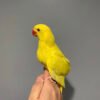Violet Indian Ringneck
$550.00
Length: 10-14inches
Weight: 350-500g
Banded: Yes
DNA Test: Yes
Sex: Males/Females
Overview Of Violet Indian Ringneck
Indian Ringnecks, also known as Ring-necked Parakeets, are popular pets due to their beauty and intelligence. Violet Indian Ringnecks are a color variety with stunning purple feathers. They are known for their ability to mimic sounds and words, and make joyful and sociable companions. These birds require a balanced diet, ample space to fly, and plenty of interaction and mental stimulation to thrive. Violet Indian Ringnecks are a specific color variety of the Indian Ringneck Parakeet. Their plumage is characterized by beautiful shades of purple that add a unique touch to these already charming birds. They have lively and curious personalities, and are known to be talented vocal mimics. Be sure to provide them with a balanced diet, enriching environment, and plenty of interaction to keep them happy and healthy.
Breeding And Reproduction Of Ringneck Parrots
Breeding and reproduction of Ringneck Parrots, including Violet Indian Ringnecks, can be a rewarding but complex process. Here are some key points to consider:
1. Pairing: Ensure you have a compatible male and female pair. Ringnecks are monogamous and bond strongly with their mate.
2. Nesting: Provide a suitable nest box or nesting area in their enclosure. Ringnecks may be selective about where they choose to nest.
3. Diet: Offer a nutritious diet rich in fresh fruits, vegetables, seeds, and pellets to support breeding and egg-laying.
4. Behavior: Monitor the birds for signs of courtship behavior, such as regurgitating food, mutual preening, and increased vocalizations.
5. Egg-laying: The female will lay eggs (usually 4-6) in the nesting area. Ensure the environment is quiet and stress-free during this time.
6. Incubation: The female will typically incubate the eggs for about 23-24 days until they hatch.
7. Chicks: Once the chicks hatch, both parents will care for and feed them until they are independent.
8. Health: Regularly monitor the breeding pair and chicks for any signs of illness or issues.
Breeding Ringneck Parrots requires careful planning, dedication, and knowledge of their specific needs. It’s essential to do thorough research and consult with avian experts before attempting to breed these birds.
Care And Feeding For Violet Indian Ringneck
Taking care of Ringneck Parrots involves providing a balanced diet, a stimulating environment, and regular veterinary check-ups. Here are some tips on care and feeding for Ringneck Parrots:
1. Diet: Offer a variety of fresh fruits and vegetables, high-quality pellets, seeds, and occasional treats like nuts. Ensure fresh water is always available.
2. Housing: Provide a spacious cage with room to move and stretch their wings. Include perches, toys, and hiding spots for mental stimulation.
3. Socialization: Ringnecks are social birds and require daily interaction and mental stimulation. Spend time talking, playing, and training them.
4. Grooming: Offer baths or showers for hygiene. Trim their nails and wings as needed, and provide opportunities for them to chew and preen.
5. Healthcare: Schedule regular check-ups with an avian veterinarian to monitor their health and address any concerns promptly.
6. Environment: Keep their living area clean, free from drafts, toxins, and other potential hazards.
7. Training: Use positive reinforcement techniques to train them to step up, speak, or perform tricks. This strengthens the bond between you and your parrot.
8. Behavior: Understand their body language, vocalizations, and behavior to address any stress or health issues early on.
By providing a nutritious diet, engaging environment, and regular care, you can ensure your Ringneck Parrot leads a healthy and happy life.
Be the first to review “Violet Indian Ringneck” Cancel reply
Related products
Ringneck Parrots
Ringneck Parrots
Ringneck Parrots
Ringneck Parrots
Ringneck Parrots



























Reviews
There are no reviews yet.